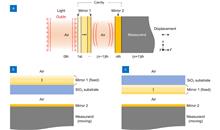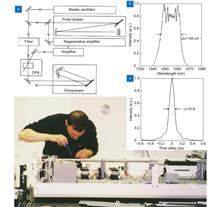 View fulltext
View fulltext
Optical cavity has long been critical for a variety of applications ranging from precise measurement to spectral analysis. A number of theories and methods have been successful in describing the optical response of a stratified optical cavity, while the inverse problem, especially the inverse design of a displacement sensitive cavity, remains a significant challenge due to the cost of computation and comprehensive performance requirements. This paper reports a novel inverse design methodology combining the characteristic matrix method, mixed-discrete variables optimization algorithm, and Monte Carlo method-based tolerance analysis. The material characteristics are indexed to enable the mixed-discrete variables optimization, which yields considerable speed and efficiency improvements. This method allows arbitrary response adjustment with technical feasibility and gives a glimpse into the analytical characterization of the optical response. Two entirely different light-displacement responses, including an asymmetric sawtooth-like response and a highly symmetric response, are dug out and experimentally achieved, which fully confirms the validity of the method. The compact Fabry-Perot cavities have a good balance between performance and feasibility, making them promising candidates for displacement transducers. More importantly, the proposed inverse design paves the way for a universal design of optical cavities, or even nanophotonic devices.
Chip-scale programmable optical signal processors are often used to flexibly manipulate the optical signals for satisfying the demands in various applications, such as lidar, radar, and artificial intelligence. Silicon photonics has unique advantages of ultra-high integration density as well as CMOS compatibility, and thus makes it possible to develop large-scale programmable optical signal processors. The challenge is the high silicon waveguides propagation losses and the high calibration complexity for all tuning elements due to the random phase errors. In this paper, we propose and demonstrate a programmable silicon photonic processor for the first time by introducing low-loss multimode photonic waveguide spirals and low-random-phase-error Mach-Zehnder switches. The present chip-scale programmable silicon photonic processor comprises a 1×4 variable power splitter based on cascaded Mach-Zehnder couplers (MZCs), four Ge/Si photodetectors, four channels of thermally-tunable optical delaylines. Each channel consists of a continuously-tuning phase shifter based on a waveguide spiral with a micro-heater and a digitally-tuning delayline realized with cascaded waveguide-spiral delaylines and MZSs for 5.68 ps time-delay step. Particularly, these waveguide spirals used here are designed to be as wide as 2 μm, enabling an ultralow propagation loss of 0.28 dB/cm. Meanwhile, these MZCs and MZSs are designed with 2-μm-wide arm waveguides, and thus the random phase errors in the MZC/MZS arms are negligible, in which case the calibration for these MZSs/MZCs becomes easy and furthermore the power consumption for compensating the phase errors can be reduced greatly. Finally, this programmable silicon photonic processor is demonstrated successfully to verify a number of distinctively different functionalities, including tunable time-delay, microwave photonic beamforming, arbitrary optical signal filtering, and arbitrary waveform generation.
The generation of power- and wavelength-scalable few optical cycle pulses remains one of the major challenges in modern laser physics. Over the past decade, the development of table-top optical parametric chirped pulse amplification-based systems was progressing at amazing speed, demonstrating excellent performance characteristics in terms of pulse duration, energy, peak power and repetition rate, which place them at the front line of modern ultrafast laser technology. At present, table-top optical parametric chirped pulse amplifiers comprise a unique class of ultrafast light sources, which currently amplify octave-spanning spectra and produce carrier-envelope phase-stable, few optical cycle pulses with multi-gigawatt to multi-terawatt peak powers and multi-watt average powers, with carrier wavelengths spanning a considerable range of the optical spectrum. This article gives an overview on the state of the art of table-top optical parametric chirped pulse amplifiers, addressing their relevant scientific and technological aspects, and provides a short outlook of practical applications in the growing field of ultrafast science.
Paper-based devices have attracted extensive attention due to the growing demand for disposable flexible electronics. Herein, we integrate semiconducting devices on cellulose paper substrate through a simple abrasion technique that yields high-performance photodetectors. A solvent-free WS2 film deposited on paper favors an effective electron-hole separation and hampers recombination. The as-prepared paper-based WS2 photodetectors exhibit a sensitive photoresponse over a wide spectral range spanning from ultraviolet (365 nm) to near-infrared (940 nm). Their responsivity value reaches up to ~270 mA W?1 at 35 V under a power density of 35 mW cm?2. A high performance photodetector was achieved by controlling the environmental exposure as the ambient oxygen molecules were found to decrease the photoresponse and stability of the WS2 photodetector. Furthermore, we have built a spectrometer using such a paper-based WS2 device as the photodetecting component to illustrate its potential application. The present work could promote the development of cost-effective disposable photodetection devices.
To increase the storage capacity in holographic data storage (HDS), the information to be stored is encoded into a complex amplitude. Fast and accurate retrieval of amplitude and phase from the reconstructed beam is necessary during data readout in HDS. In this study, we proposed a complex amplitude demodulation method based on deep learning from a single-shot diffraction intensity image and verified it by a non-interferometric lensless experiment demodulating four-level amplitude and four-level phase. By analyzing the correlation between the diffraction intensity features and the amplitude and phase encoding data pages, the inverse problem was decomposed into two backward operators denoted by two convolutional neural networks (CNNs) to demodulate amplitude and phase respectively. The experimental system is simple, stable, and robust, and it only needs a single diffraction image to realize the direct demodulation of both amplitude and phase. To our investigation, this is the first time in HDS that multilevel complex amplitude demodulation is achieved experimentally from one diffraction intensity image without iterations.
All inorganic CsPbBr3 quantum dots (QDs) are regarded as excellent candidates for next-generation emitters due to their high photoluminescence quantum yield (PLQY) and defect tolerance. However, the poor stability and degraded luminescent performance may impede their further commercialization because of the separation of conventional ligands from the QDs surfaces. Recently, Zang replaced the regular oleic acid with 2-hexyl-decanoic acid (DA), which possesses higher binding energy on the QDs surfaces, to act as ligands of QDs, exhibiting PLQY of 96% and excellent stabilities against ethanol and water. WLEDs with DA-modified CsPbBr3 QDs achieved improved thermal stability, a color rendering index of 93, a power efficiency of 64.8 lm/W and a properly correlated color temperature value of 3018 K, implying their prominent applications in solid-state lighting and displays.














